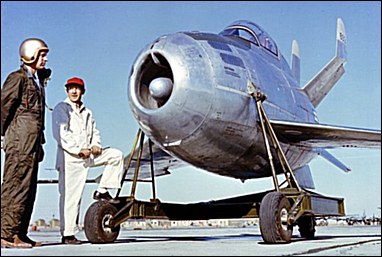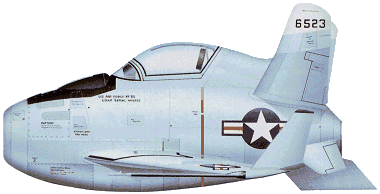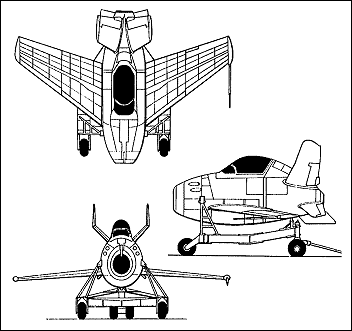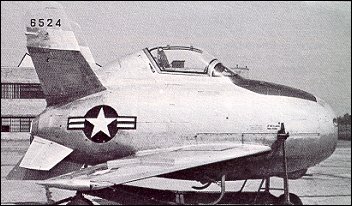 |
McDonnell XF-85 Goblin1948 |  |
| PARASITE FIGHTER | Virtual Aircraft Museum / USA / McDonnell Douglas |
 |
The McDonnell XF-85 Goblin was the only USAF aircraft ever conceived from the outset as a 'parasite' fighter to be carried aboard bombers, in the same manner by which the converted Republic RF-84K Thunderflash was employed operationally for a time. Designed by Herman D. Barkey, the XF-85 was to be stowed in the number one or four bomb bay of the B-36 intercontinental bomber. Over target, it would be dropped free to protect the B-36 from enemy interceptors. Because of its unusual task, the XF-85 Goblin was a unique design. It had 36-degree swept wings which folded upward from the root for storage inside its mother ship. It had an odd-looking, X-shaped tail, although flight controls were conventional. Equipped with a probe or 'skyhook' designed to engage a trapeze lowered by the bomber (a process much like threading a needle) the XF-85 was powered by a 1360kg thrust Westinghouse J34-WE-12 turbojet engine. In 1947, indoor tests were begun to evaluate the mating arrangement between the Goblin and a mock-up of a B-36 fuselage. On 9 November 1947 the first of two XF-85s was disassembled at the manufacturer's St Louis plant and flown aboard a C-97 transport to Moffett Field, California, for wind-tunnel tests. While being positioned in the tunnel, the aircraft fell 12.2 m, was badly damaged, and had to be returned to St Louis, being replaced at Moffett by the second machine. On 5 June 1948, this second XF-85 was transported to Muroc AFB, California, and, with no B-36 airframe available for evaluation of the parasite fighter concept, experiments began using an EB-29B Superfortress. Ed Schoch, a former US Navy F6F Hellcat pilot with four air combat kills in the Pacific war, was the only man ever to fly the XF-85. His first attempt nearly killed him. On 23 August 1948, Schoch was attempting to re-engage the bomber's trapeze when he slammed into it, shattering his canopy, ripping his helmet off, and knocking him unconscious. Schoch recovered in time to make a shaky landing on the XF-85's underside skid in the Muroc desert, damaging the plane. The second flight on 14 October 1948, resulted in a normal mid-air drop and subsequent hook-up. Three more times, however, struggling to manoeuvre the tricky Goblin, Schoch was forced to make belly landings in the desert rather than regain his link-up with the Superfortress. On 8 April 1949, the original XF-85 made its first and only flight. In budget-lean 1949, the XF-85 programme was quietly terminated, although the Strategic Air Command eventually became interested in the parasite fighter concept when it became possible to carry an RF-84K aboard a B-36. The first XF-85 is on display at the Air Force Museum in Dayton, Ohio, while the second is at the Strategic Air Command Museum in Omaha, Nebraska, displayed in highly inaccurate markings with a spurious tail number. FACTS AND FIGURES
 © In front of the cockpit was a large hook on which the XF-85 would be lowered and retrieved in flight. © As it was intended to take off and land under its carrier aircraft, the Goblin only had a skid landing gear and needed a surface such as a dry lake to land on. © The fins were canted upwards near their tips so as to fir in the narrow bomb bay of the B-29. The wings folded for stowage in the bomber. McDonnell XF-85 Goblin on YOUTUBE
|  COMPANY PROFILE | |||||||||||||||||||||||||||||||||||||||||||
 |

|



Can you see a tail number in your photo? Is there any way you could email me the photo?
reply